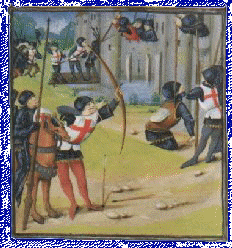| With Scotland firmly at his
feet, Edward resumed his role of umpire for the
succession to the Scottish crown, and in the great hall
of Berwick Castle on 17th November 1292 he declared : 'Bruce shall take nothing in the competition with Balliol, and John Balliol shall have seisin [possession] of this kingdom of Scotland' but he was careful to add 'This judgement shall not impair my claim on the prperty of Scotland'. So Balliol, a tractable vassal, was crowned at Scone on St Andrews Day 1292. Although the most important castles were then nominally surrendered to him, they were still occupied by their Anglo-Norman governors and garrisons. Edward lost no time in humiliating Balliol, compelling him to appear in English courts as a defendant in various cases brought by his own subjects. Appearing at an English parliament in 1293 to answer an appeal about lands in Fife, Balliol lst his patience, whereupon he was judged guilty of contempt of court and the three principal towns and castles of Scotland with their royal jurisdiction were forfeited to Edward. With the country at the mercy of Edward's men, there were frequent skirmishes between English |
 John Balliol and his wife |
